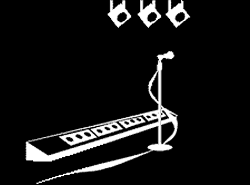A funny thing about the audience seeing cellist Matt Haimovitz at the Tractor Tavern on Saturday, Jan. 21: They were dead silent during the music (considerably quieter than the average Seattle Symphony audience, for instance), and they didn’t applaud between movements. These are two aspects, we’re often told, of the sort of oppressive, ritualistic etiquette that keeps people away from classical concerts. Yet here was a packed house (as at Haimovitz’s last two Tractor concerts, people were turned away) in a venue that presumably allows for more rowdiness than Benaroya Hall, following impeccably, and of their own accord, the strictest conventions of concert behavior. Not because it was imposed by stuffy elitist classical peer pressure, but because—hello!—it’s the best way to hear this sort of music.
It’s all about detail, after all. Haimovitz played the first two of Bach’s six suites for solo cello, stylized versions of dances popular in his day, finding an ideal blend of dance and stylization, of personal expression and formal convention. Linger too long over a phrase ending and the music’s rhythmic backbone goes flabby; play too rigidly and you put everyone to sleep. And the audience was perfectly content to shut up and attend to these subtleties with a focus not incompatible with the drinking of beer. (As Haimovitz and others have pointed out, Bach himself never played in what we think of as a concert hall; all his music-making was done at home, in church, or at coffeehouses and taverns not unlike the Tractor.)
A sonata by Gyorgy Ligeti (best known for the eerie “monolith music” in 2001: A Space Odyssey) included, among streams of plangent melody, weird little plucked chords, pitch-bent in Hawaiian-guitar style just as they faded away. In the second movement, Haimovitz’s left hand clambered all over his cello in fast music full of skittering, stuttering electric jolts.
Returning to the idea of dance music as concert music, Haimovitz played an earthy fantasy by Osvaldo Golijov based on an old Argentinian tango. After intermission, three of his students joined him for Bartok’s Rumanian Folk Dances, in an arrangement full of sonic effects that sometimes recalled the sounds of the folk instruments that Bartok took as his inspiration—and sometimes, uncannily, even recalled the sounds of the wax-cylinder field recordings that Bartok made 100 years ago.
I’ve played the cello myself for 30 years, and I was still startled by some of the freakish and beautiful colors these four conjured—all acoustically. (For example, the sorts of fuzzy distortion effects electric guitarists need pedals for, cellists can create just by moving their bow a little farther down the strings.) These effects even included percussion in a fantastic arrangement of Led Zeppelin’s “Kashmir,” the fourth cellist slapping and tapping his instrument all over. Haimovitz followed this with his own solo deconstruction of Hendrix’s Woodstock rendition of “The Star-Spangled Banner,” and in his hands it’s protest music maybe even angrier than the original.







